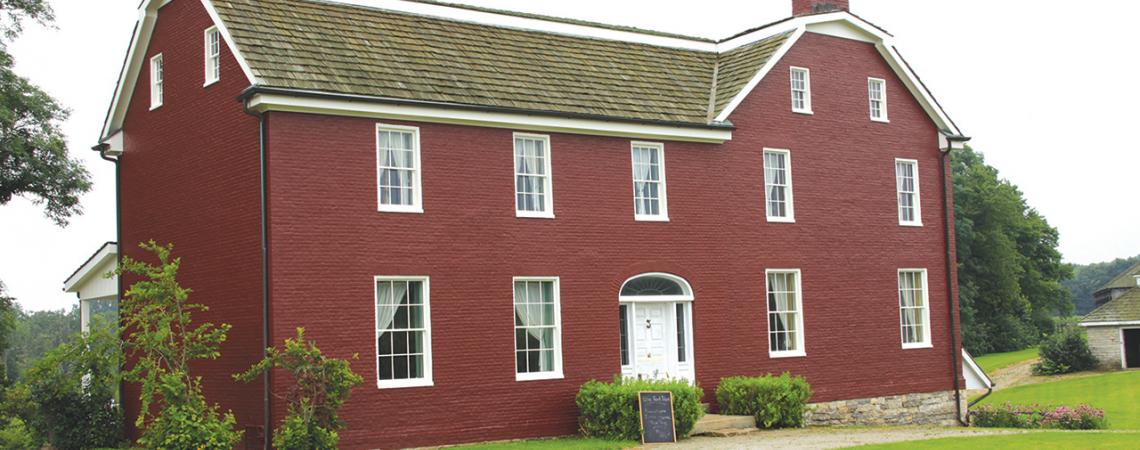The Old Johnston Farm and Indian Agency in Piqua takes visitors back to explore what life was like in 1800s frontier Ohio during John Johnston’s time as Federal Indian Agent. The historic site includes Johnston’s preserved farmhouse mansion, mule-towed canal boats, and more. (Photo by Chip Gross)
During the early 1800s, Ohio was the western edge of America’s frontier. A few Native American tribes still remained in the state, but the Indian Removal Act numbered their days. Passed by the U.S. Congress in 1830, the Act required all Indians living on reservations to move west of the Mississippi. The last to leave the Buckeye State were the Wyandot, and the man tasked with making that happen was John Johnston (1774–1861).
“Johnston was a good choice for the job because he was highly respected by both the Indians and whites,” says Andy Hite, site manager of the historic Johnston Farm and Indian Agency, located near Piqua, Ohio. “It took a great amount of skill and diplomacy to do what he did.”
Frontier introduction
Born in Ireland, Johnston emigrated to America at the age of 12 and settled in Pennsylvania, eventually finding work hauling supplies by wagon to Anthony Wayne’s army supply post at Fort Piqua.
Right around 1800, at age 26, Johnston became involved with a young woman named Rachel Robinson, who was 16 at the time. The problem with the budding romance was that Rachel was Quaker by religion and John was Episcopal; to say the least, Rachel’s parents didn’t approve. The two young lovers solved the problem by eloping to Lancaster, Pennsylvania.
Their honeymoon was an 850-mile horseback trip through the wilderness from Pennsylvania to Indian Territory (now Indiana) where Johnston had accepted a job as an Indian Factor, running the government trading post at Fort Wayne. The position was Johnston’s introduction to Native American culture. He became adept at dealing with the tribesmen of the region and was eventually promoted to Federal Indian Agent.
Called back to service
He remained in that position until 1811, when he and Rachel moved to their farm near Piqua, onto land Johnston had first seen years before and subsequently purchased in 1804. Their marriage and lives there were prolific; they had 15 children (five boys and 10 girls), and all but one lived into adulthood. It was during this time in his life as a “gentleman farmer,” as he liked to refer to himself, that Johnston was called out of retirement by the federal government to act as the Indian Agent for western Ohio when the War of 1812 broke out.
His farm became the site of the new Indian agency from which he oversaw the Shawnees beginning in 1812, adding the Seneca and Wyandot tribes in 1816.
Johnston was ousted from his position in 1829 when a new presidential administration (Andrew Jackson) took over in Washington. Yet, he was still willing to help his friends the Wyandot relocate when they left in 1843.
See for yourself
If you’d like to experience what life was like on the Ohio frontier, the Johnston Farm and Indian Agency (www.johnstonfarmohio.com) is open Thursday through Sunday from June through August; and by special appointment in April, May, September, and October.
Start your visit at the museum to get a sense of the Native American influence surrounding the area, then take a tour of the red-brick farmhouse — considered a mansion during its time — the rooms furnished with period furniture.
“We like to keep the house looking as if the original occupants have just stepped out of the room,” Hite says. “So you might see Rachel’s needlework left on a sofa, kids’ toys scattered in a corner, or important papers lying on John’s writing desk.”
No visit to the farm is complete without a canal-boat ride on the section of the Miami and Erie Canal that passes through the property. Pulled by a mule or two, the canal boat moves just a few miles per hour. “Canal-boat operators were fined if they exceeded the speed limit of 4 miles per hour,” Hite says, “as the wake from boats eroded the canal banks.”
W.H. “Chip” Gross is Ohio Cooperative Living‘s outdoors editor.









